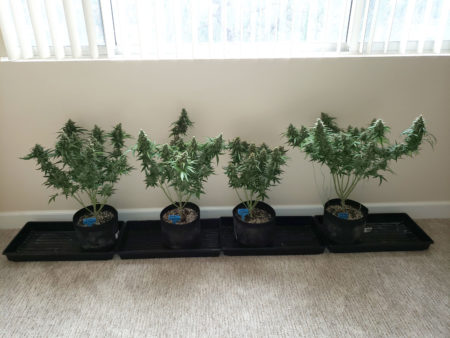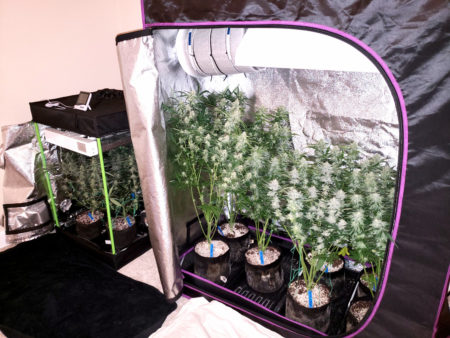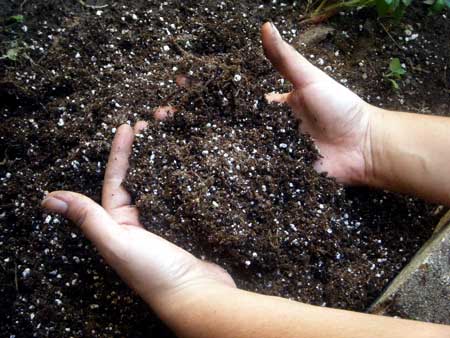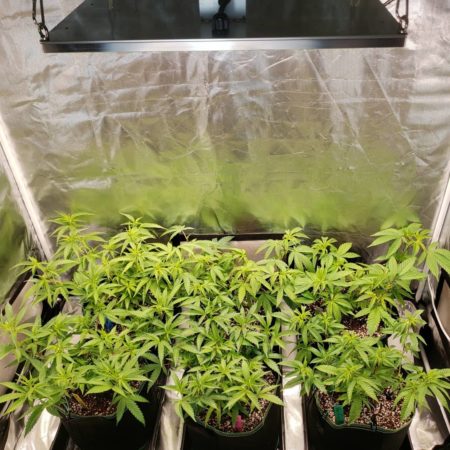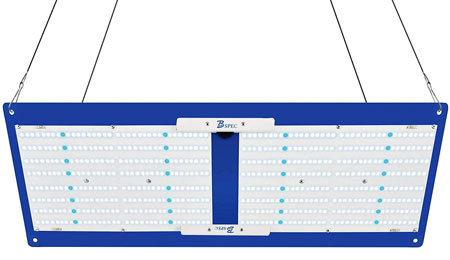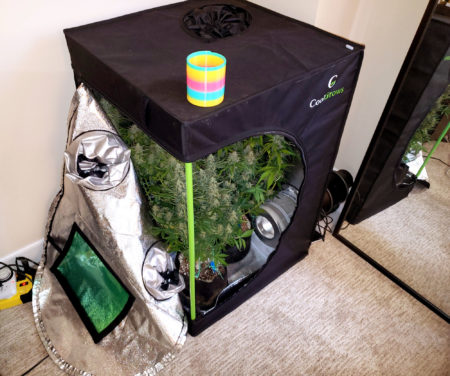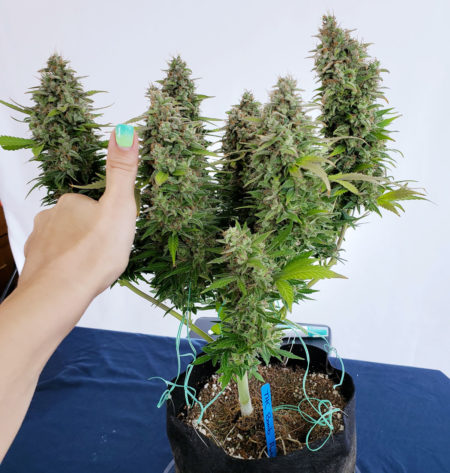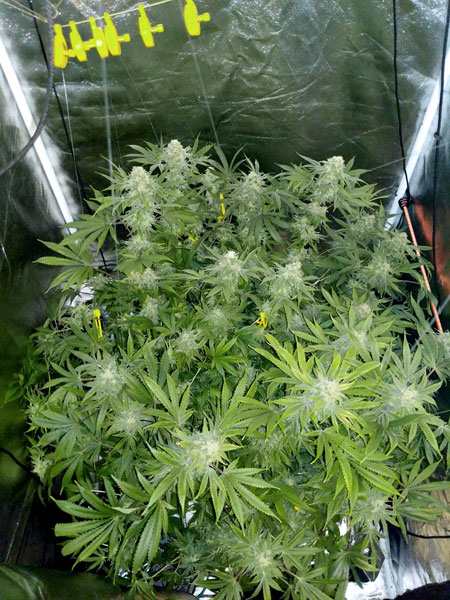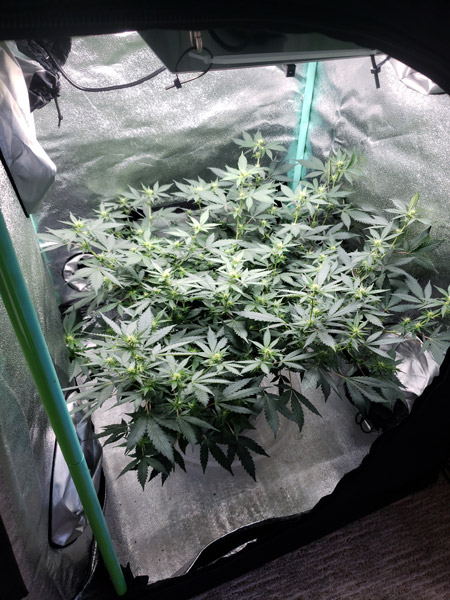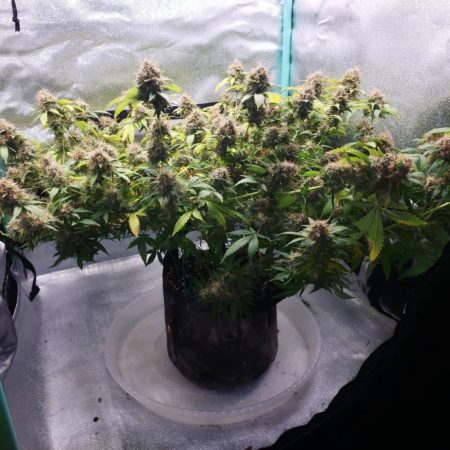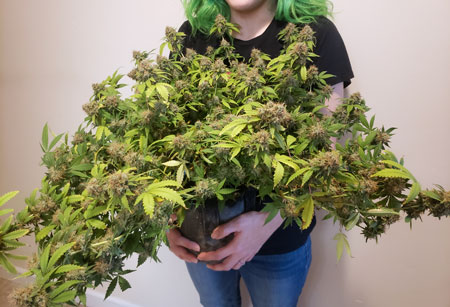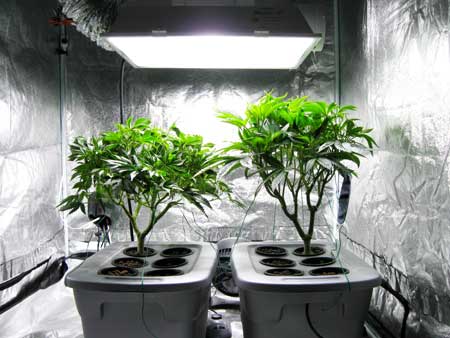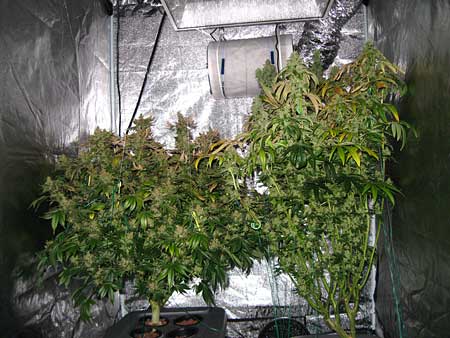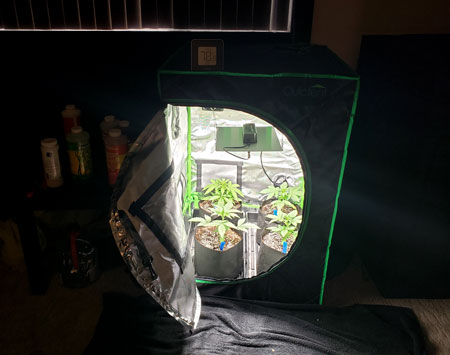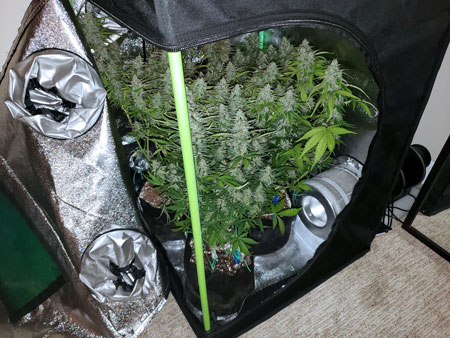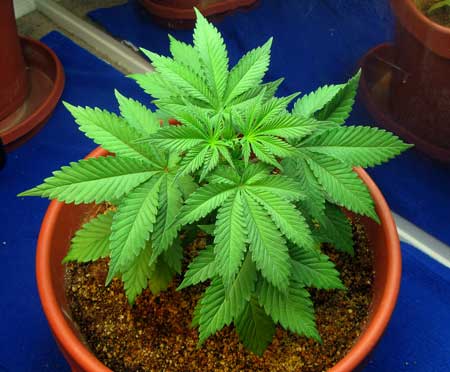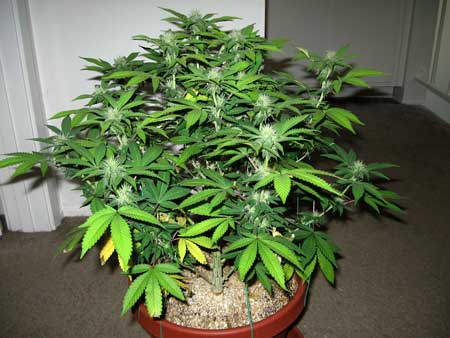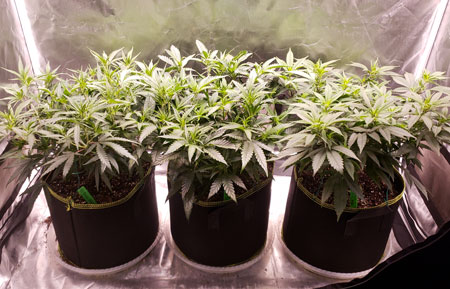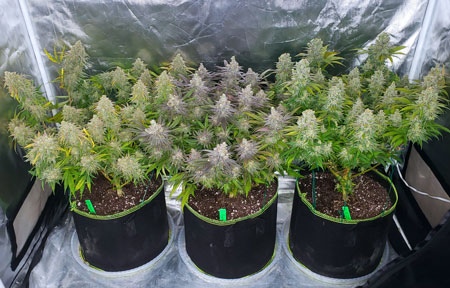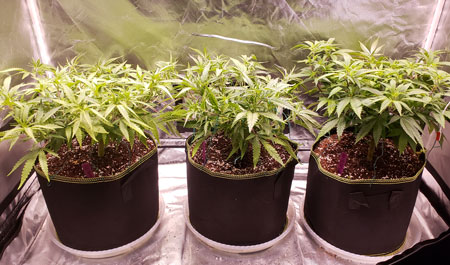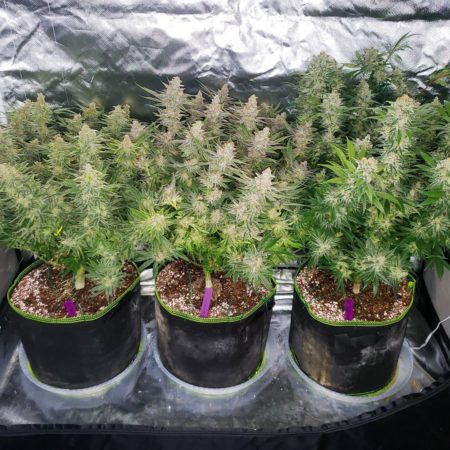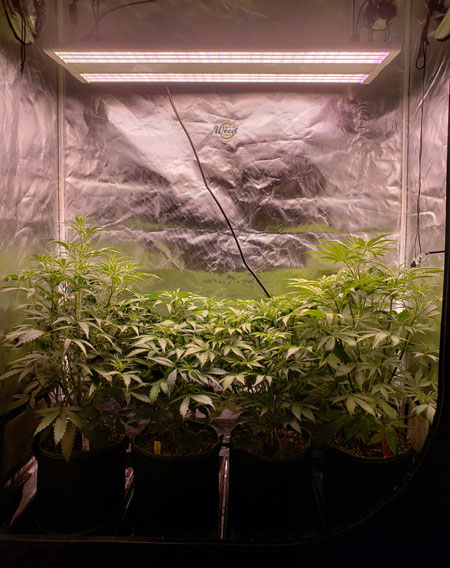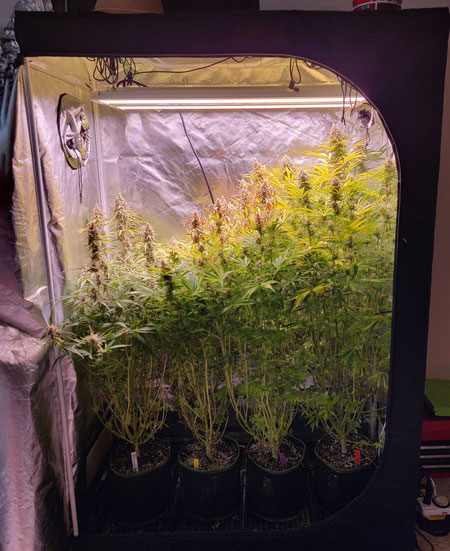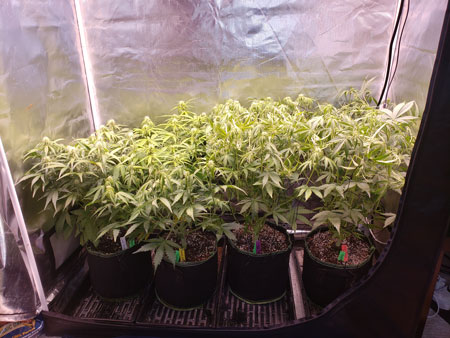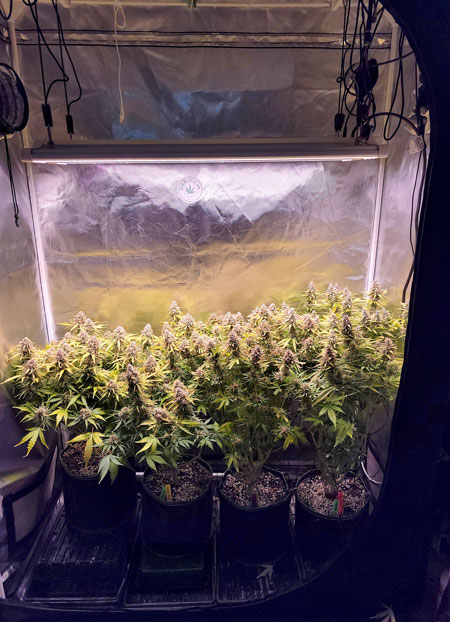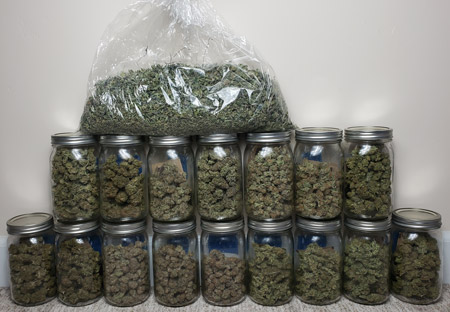by Nebula Haze
This cannabis height control tutorial will teach you how to use bending and training techniques made specifically for cannabis plants (such as LST / low-stress training, supercropping, topping, FIMing, ScrOG, or using a screen or netting, etc.).
It’s easy to control marijuana plant height, but you need to understand 3 things. Once you understand these three principles, you’ll be able to force indoor plants to grow into the exact shape and size that you want.
- Setup – Choose the right setup (pot size, grow medium, grow light, strain) to naturally help produce plants the size you want – details below
- Plant training – Learn how to force plants to grow flat and wide instead of tall (or whatever shape you want), and discover techniques to reduce the size of out-of-control plants
- Flowering stretch – Understand how plant height is affected in the flowering stage and how to use this to your advantage.
Let me go through those quickly. Soon you’ll be able to create plants in whatever size you want
1.) Setup
The setup you use can actually cause plants to grow taller than necessary. Here are some things to keep in mind.
Pot size – Smaller pots (restricting root size) will help keep plants smaller. They can still get big if you keep them watered and happy, but it will take them longer to get big compared to a plant with unrestricted roots. For example, if given the exact same conditions and amount of time, 1-gallon pots tend to keep plants small, 3-gallon pots tend to produce mid-size plants, while 7-gallon pots can produce humongous plants indoors. I usually grow with 1 or 2-gallon pots in a mini tent, 3 or 5-gallon pots in a 2’x4′ grow tent, and 5-gallon pots in a 4’x4’x6.5′ grow tent. Note: smaller pots need to be watered more often so there is a tradeoff.
Smaller pots tend to keep plants smaller, bigger pots tend to result in bigger plants
Grow medium – Plants tend to stay a little smaller in soil (especially when grown without nutrients in a “just add water” setup) vs in coco or especially hydro.
Grow light type – Choose a type of grow light that tends to keep plants short
- Best: LEDs and MH (metal halide) grow lights tend to keep weed plants shorter. MH should only be used in the vegetative stage so LEDs are one of the best choices to use from seed to harvest if you want to keep plants short.
- Okay: Fluorescent lights like T5s or CFLs must be kept extremely close to plants to prevent them from “stretching” tall towards the light. However, if the light intensity is high enough, plants will stay short.
- Worst: HPS and CMH/LEC grow lights (especially when using a Bloom/3k bulb) produce extra height in less time. These grow lights tend to cause plants to grow tall and stretchy (with lots of stem between each set of leaves) in the vegetative stage, as well as in the flowering stage to a lesser extent (though both types of light reward you for your trouble with incredible bud yields and density)
Good LED grow lights help prevent stretchy plants
Grow light spectrum
- Blue light is usually listed between 4000k-6500k as the color of the grow light spectrum (if you see nanometer measurements for individual diodes, blue is in the 450-495nm range) tends to keep plants shorter and bushier. Often the grow light or bulb will say they’re best suited to “vegetative” growth. They tend to get smaller yields when used in the flowering stage, though they can help increase “sparkle” (trichome production) on buds.
- Red light is usually listed between 2500k-4000k as the color of the grow light spectrum (red is in the 625-750nm range) tends to cause plants to grow more stretchy and tall. Often these are listed as “Bloom”, “Flowering”, or “Red Spectrum” grow lights. In the flowering stage, they produce higher bud yields.
- Mixed spectrum – These lights contain a mix of everything and give you a mixture of effects depending on the ratio.
Using an LED with high amounts of blue light (like this HLG 300 B-spec) designed for the vegetative stage helps encourage plants to grow short and bushy instead of tall and stretchy, though yields tend to be a bit smaller if you don’t switch to a flowering grow light for the flowering stage
Grow a Short Strain – Some strains tend to stay short while others tend to get tall no matter what you do. In general, autoflowering strains tend to stay smaller, but over the last few years I’ve noticed many of the newer strains can still get alarmingly big unless specifically listed as a “short strain”.
Choose a good setup to grow short plants. For example, mini tents with tiny grow lights can be surprisingly productive when you recommended supplies and instructions in the mini tent setup tutorial. This grow produced over 5 ounces with an HLG 100 V2 (R-Spec version) and 4 plants in 2-gallon fabric pots.
Note: As you can see with the mini tent example above, as long as you follow the rest of the instructions you can still keep plants short with a bloom grow light from seed to harvest.
Auto-flowering strains that tend to stay short
- Bubblelicious Autoflower – Classic effects that are relaxing but not overwhelming, easy to grow, and smells amazing
- C4 Auto – Purple buds, fast finishing, easy to grow, average-to-high potency
- NYC Diesel Autoflower – Fuel or gas smell, high potency, “uplifting” and “creative” psychological effects are excellent during the day
- THC Bomb Autoflower – Resistant to problems, buds sparkle, very high potency
- Wedding Cake Autoflower – Distinctly Californian sweet smell, high potency, “body high” and “heavy” effects are a great way to end a long day
THC Bomb Auto plants tend to stay short and produce above-average potency and yields
Photoperiod strains that tend to stay short
- Bubble Bomb – Beautiful sparkly buds, hint of bubblegum scent, good yields, high potency
- Cream Caramel – Exceptional sweet smell and taste, easy to grow, very high potency
- Critical (Royal Queen version) – Great yields, easy-going, quick time to harvest, high potency but not overwhelming effects
- Hash Plant – Easy to grow, quick to harvest, old school chill classic 90s effects with an extra kick
- Tropicana Cookies Purple – Buds take on purple tints, excellent smell, potent and long-lasting effects
- Tutankhamon (King Tut) – Relatively low smell (which may be better for stealth), extra high potency
Tutankhamon plants don’t have a strong smell, which may be a good thing in a stealth setup. This grower used plant yo-yos to hold up heavy branches.
2.) Plant Training
Use bending and tie-down techniques on cannabis plants from seed to harvest; it’s the easiest way to control height. The idea is simple:
- Top plants (cut off the top) when they are small to make plants naturally grow more wide and bushy. A good time to cut off the top is when the plant has about 6 sets of leaves.
- Bend over tall branches and tie them down – When any branch or stem starts getting significantly taller than the other branches, gently bend it down and away from the center of the plant. Tie it in place using something like plant twist-ties attached to your plant pot (bend twist-ties around the lip of the plant container, or poke them through a fabric pot).
- Use the cannabis-specific supercropping technique if you need to bend a branch that is already hardened and would normally break if you try to bend it.
- Try to maintain a flat, wide shape so all parts of the plant are the same distance from the grow light. The wider the plants, the less they tend to get tall since you have lots of branches that all need to lengthen, instead of just one main branch.
Check out our simple cannabis plant training guide for complete instructions. This can be used in any setup. Or check out the mini tent tutorial if you want directions to grow in a mini tent.
This plant is in a 3-foot tent (shorter than my waist), yet still produced several ounces of bud under an HLG 65 4000k (blue spectrum 65W LED grow light, highly recommended for small spaces). Check out the full mini tent tutorial if you want to copy this grow style at home.
Here’s that plant at harvest. Still short, just covered in buds.
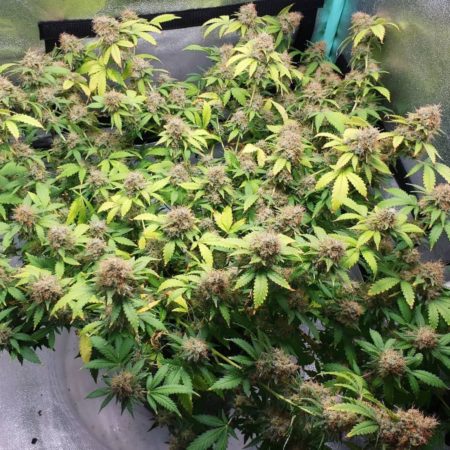
This is me holding that plant as the buds fell over from the weight
Check out the full mini tent tutorial for step-by-step instructions and pictures on how I trained this plant (it’s easy to copy these results once you know what to do).
3.) Flowering Stretch
It’s important to understand that cannabis plants will about double in height on average after they start flowering (making buds). This is often referred to as the “flowering stretch.” Not being prepared for this growth spurt is often the root cause of height trouble for many marijuana growers. If you wait until your plants are the right height and then initiate flowering (give plants a 12/12 light schedule on a timer to imitate late summer nights), you will end up with plants that are twice the size you wanted. No good.
Here’s how to make the flowering stretch work for you:
- Cannabis plants get significantly taller after they start flowering. Therefore you want to initiate flowering when they’re about half the final desired size.
- A general rule of thumb is cannabis plants double in size after they started flowering. However, strains listed as “short” tend to stretch less, or not much at all. Strains listed as “tall” may triple in height or more.
- If you initiate flowering on a plant that’s less than 4 or 5 weeks old, it tends to stretch more because it takes longer to start flowering so the “stretch” lasts longer
- Topping plants when they’re young and training them to grow multiple branches (as explained in step 2) reduces the amount of height gained during the flowering stage because this spreads out the upward growth between multiple branches vs having all the height go into one main stem.
- Flowering stage defoliation (removing leaves in a strategic way) and supercropping (bending thick stems) during the flowering stretch tend to slow upward growth.
- When you’re adding nutrients to the water, plants tend to grow faster (stretch more) than if they’re living off the nutrients in the soil.
Let’s go through some real-life examples of flowering stretch to help give you an idea of what to expect. I wish I had seen this when I started growing as it would have saved me some height headaches.
Different strains
Strain makes a big difference when it comes to final cannabis plant height after the flowering stretch. These two plants were grown in identical conditions but were two different strains. This is what they looked like after some plant training. You can see the plant on the right already wants to be tall. I started giving a 12/12 light schedule right after this picture to switch the plants to the flowering stage.
Here are the same plants at harvest. The left plant is a “short” strain and barely stretched. The right plant is a “tall” strain and doubled in height.
3 Weeks Old
These cannabis plants were 3 weeks old when I initiated the flowering stage by giving a 12/12 light schedule. Since these plants were still young, I knew they could more than double in height. Young plants take longer to start flowering and tend to stretch more.
Their height at harvest (about 3x height after the stretch)
4 Weeks Old
I initiated this 4-week old plant to start flowering at this height
It ended up about 2.5x height after the flowering stretch was over
12″ tall – super soil (no nutrients)
These soil-grown plants (grown in “just add water” super soil without nutrients) are about 12″ (30 cm) tall when flowering was initiated.
Here are those plants at harvest. They ended up about 20″ (50 cm) tall after the flowering stretch. They grew taller but didn’t quite double in size. Cannabis plants tend to stretch less in soil without added nutrients.
12″ tall – coco coir (using nutrients)
Plants grown in coco or hydro with nutrients tend to stretch more. These plants are clones of the above plants, in the same setup, which were also initiated to start flowering at about 12″ tall. However, these plants were grown in coco with nutrients.
The coco plants were significantly taller at harvest, about 30″. So they more than doubled in height even though everything else was the same except the grow medium and using nutrients. Just something to keep in mind if you’re trying to keep plants short. However, these were in 5-gallon pots. I’ve found small pot size helps reduce flowering stretch especially in coco.
Flowering starts too late (untrained)
Here’s an example to show what happens when you don’t do any training and flowering starts too late. These plants are autoflowering strains which means that flowering starts on its own automatically after 3-6 weeks (everything else is the same as standard/photoperiod strains). The plants were left to grow naturally without topping or training and this was their natural shape. The tallest plants were 24″ tall when flowering started.
Check out the insane flowering stretch. At harvest, the plants had grown into these beasts. This also shows how some strains “stretch” more than others. I hope this helps illustrate why it’s important to choose “short” strains and start flowering at the right time. It also demonstrates what can happen if you don’t use any bending and training to control height during the vegetative or flowering stage (I was pretty shocked by this).
Trained to stay short and flat
The sister plants to those out-of-control plants (same strains in a different tent) show the power of training to reduce the flowering stretch. These plants were trained to be short with multiple branches per plant (instead of just one main trunk like the above example). Not only does this keep plants shorter overall, but it also reduces the amount of height gained during flowering since the upward growth gets spread between many branches at the same time.
I did have to do a little more bending as they grew, but you can see at harvest how much better the height was controlled. I would have been able to grow these plants in a significantly shorter space while the other tent was overflowing. Bonus: These plants actually yielded more weed than the ones in the untrained tent. Plant training not just controls height but can increase yields significantly by forcing plants to grow many big buds instead of just a few.
Summary: How to Control Cannabis Plant Height
Remember these 3 things
- Setup – Choose the right pot size, grow medium, grow light, and strain to naturally help produce plants the size you want
- Plant training – Force plants to grow flat and wide instead of tall
- Flowering stretch – Understand how plant height is affected in the flowering stage and use this to your advantage.
You now have the understanding you need to become an expert at cannabis plant height. Time to grow topiary-level cannabis plants with great yields!

